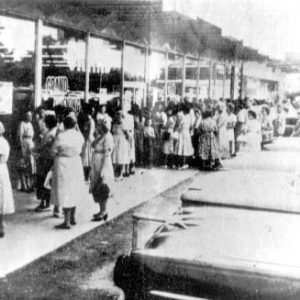calsfoundation@cals.org
Walmart Inc.
aka: Wal-Mart Stores, Inc.
Founded in 1962 by Sam Walton, Walmart Inc., the world’s most profitable retail outlet for many years, also became the largest employer in the United States, with more than one million employees (called “associates”) and thousands of stores worldwide. For most of its history, it has been closely identified with its founder, whose homespun image often belied the aggressive, innovative business model he developed.
Born near Kingfisher, Oklahoma, on March 29, 1918, Walton grew up during the Depression, working on his family’s farm and at a number of other jobs. After graduating from the University of Missouri at Columbia, he took a job in Des Moines, Iowa, as a management trainee for clothing retailer J. C. Penney, earning seventy-five dollars a month. After serving in the U.S. Army during World War II, Walton decided, in 1945, to open his own department store. Acquiring $20,000 in capital from his father-in-law, he purchased a Butler Brothers franchise store (Ben Franklin) in Newport (Jackson County). Though it would be another seventeen years before he established the first Wal-Mart outlet, the company’s eventual business practices were formulated during the 1940s and 1950s. Walton proved to be innovative in improving “throughput”—the tight control of inventory flow that is necessary to maximize profits. Walton maintained constantly stocked shelves and kept tabs on which items sold and which did not. He also began the practice of buying goods wholesale and selling them to consumers at discounted prices. This was the Wal-Mart method: offering low prices that spurred increased sales volume. It led to the company’s greater purchasing power, allowing Walton to wrangle ever more beneficial prices from manufacturers.
The success of his Newport outlet—which Walton later sold for a profit—led to the establishment of more stores. In 1950, “Walton’s 5 & 10” debuted in Bentonville (Benton County), a town that would eventually become the site of Wal-Mart’s corporate headquarters. Its proximity to Midwestern markets, such as Kansas City, proved especially beneficial. Walton continued to develop practices that today form the bedrock of Wal-Mart’s success. He scoured the region in an effort to lure away top managers from other retailers. He also introduced centrally located cash registers, allowing customers to purchase all their items at once. This replaced the comparatively inefficient method of having cash registers located throughout a store. Also during this period, Walton began to offer employee profit-sharing, engendering greater employee loyalty and production. Limited partners within company management were allowed to invest up to $1,000 in new stores.
The first Wal-Mart opened its doors in 1962 in Rogers (Benton County). Throughout the 1960s, the company opened new stores, concentrating initially on rural towns in which a new Wal-Mart would often become a community’s central retail outlet. As Nelson Lichtenstein has observed, the decision to base operations in northwestern Arkansas insulated the company from civil rights–era efforts to desegregate businesses. In 1970, the company, now incorporated as Wal-Mart Stores, Inc., opened its first distribution center and its home office, both located in Bentonville. In that year, Wal-Mart also made an initial public offering of its stock, which for the next two years was unlisted on a major exchange, and thus traded “over the counter.” In 1972, the company was first listed on the New York Stock Exchange, where it began a rapid ascent in share value. By March of that year, Wal-Mart stock had undergone its first 100 percent split and was trading at forty-seven dollars per share. It split again later that year, and yet again in August 1975.
As Wal-Mart continued its rapid growth, it also made its first acquisition of other retail chains. In 1977, it purchased sixteen Mohr-Value stores in Michigan and Illinois and acquired Hutcheson Shoe Company the following year. By the end of the 1970s, Wal-Mart had expanded into a number of different services in its stores—selling pharmaceuticals, adding auto service centers, and introducing jewelry divisions. Such diversification quickly proved fruitful, as the company announced in 1979 that, for the first time, annual sales had reached more than $1 billion. As its stock continued to rise—splitting in 1980 and again in 1982—Wal-Mart built dozens of new outlets across the United States.
In 1983, Wal-Mart introduced several innovative changes and also opened its first Sam’s Clubs, wholesale stores that offered members the opportunity to purchase goods in bulk. As its stock soared to more than eighty dollars per share in late 1983, Wal-Mart acquired Woolco Stores, initiated its “People Greeter” program, and established one-hour photo labs within its outlets. By 1984, Wal-Mart had become a leader in the retail industry, and to celebrate the company meeting its fourth-quarter goals for the previous year, Walton fulfilled a promise made to shareholders by hula-dancing on Wall Street. He named David Glass as company president that same year. Under Glass’s leadership, Wal-Mart entered its most expansive and profitable period. Glass, who would be named Chief Executive Officer (CEO) in 1988, began a new phase in the company’s history, launching a massive expansion program resulting in hundreds of new stores over the next decade. Glass stepped down from his position as CEO in 2000, and was succeeded by H. Lee Scott Jr.
In 1988, the first Wal-Mart Supercenter opened, offering twenty-four-hour shopping, groceries, and, eventually, banking, gas stations, and McDonald’s fast food. By 1990, Wal-Mart sales had surpassed rivals such as Kmart and Target. In 1991, the company made its first foray into the international market, opening Club Aurrera in Mexico City. This would become the next phase of Wal-Mart’s strategy for success: expansion into foreign markets such as Europe, Asia, and South America. In 1996, the company gained access to lucrative emerging markets in China and South Korea. The following year, it replaced Woolworth on the Dow Jones Industrial Average, signaling its emergence as a significant force in the overall U.S. economy.
By the late 1990s, Wal-Mart had become the target of critics who charged that the company’s aggressive tactics hurt small businesses. Complaints also came from major manufacturers such as Rubbermaid, which claimed that Wal-Mart unfairly negotiated prices. In 2004, the company faced the largest class action suit in American history, as a group of female employees accused the company of discrimination against women in its promotion practices. Indeed, the critique of Wal-Mart developed, by 2005, into a torrent of complaints and accusations. Several books and documentaries charged the company with numerous violations of the law, including denying employees overtime pay, locking workers overnight in its stores, contributing to environmental degradation and suburban sprawl, and supporting Asian sweatshop labor. To combat increasing criticism, Wal-Mart launched an advertising campaign aimed at improving its image in early 2005. It also continued its considerable charitable contributions. Since 1998, Wal-Mart and the Walton Foundation have annually given in excess of $100 million to various causes. In the fall of 2005, Wal-Mart garnered media attention for its delivery of relief supplies to victims of Hurricanes Katrina and Rita, which devastated the Gulf Coast. In 2008, the company changed the spelling of its name to Walmart, and in late 2017, it announced the change of its legal name to Walmart Inc. effective February 2018.
In 2014, Walmart was the largest private employer in the United States, and members of the Walton family regularly rank among the ten wealthiest individuals in the nation. In fiscal year 2014, Walmart, which operates in twenty-seven countries, brought in $437.1 billion in revenue.
In July 2015, Walmart purchased the remaining shares of the Chinese online retailer Yihaodian (it had already owned 51% of the company) in an effort to gain more Internet customers in China. However, some of the company’s international expansion has rested upon illegal acts. For example, in 2012, the New York Times reported that Walmart’s subsidiary in Mexico had succeeded in gaining market dominance through a campaign of bribery; an internal investigation into the matter was later shut down by company leaders. In 2019, Walmart was fined $282 million by the federal government for multiple violations of the Foreign Corrupt Practices Act, including several cases of bribery and other crimes in Brazil, China, India, and Mexico.
It was reported in the New York Times in August 2021 that Amazon had bested Walmart to become the world’s largest retail seller outside China; Walmart remained the largest private employer in the United States, however, with 1.6 million workers. Walmart was also reported as selling more within the United States than Amazon, though many think Amazon will soon surpass Walmart in sales in the United States, further evidence of the migration of shoppers to exclusively online retailers.
In August 2022, Walmart announced that it was expanding its abortion coverage for employees, stating in a memo that its healthcare plans would cover abortion for employees “when there is a health risk to the mother, rape or incest, ectopic pregnancy, miscarriage or lack of fetal viability.” The new policy would also offer “travel support” if needed for employees (as well as their dependents) seeking abortions covered under its healthcare plans.
In January 2023, Walmart announced in a memo to employees that it was increasing its minimum wages for store associates from a range of $12 to $18 an hour to a range of $14 to $19 an hour.
For additional information:
Blanco, Anthony. The Bully of Bentonville: How the High Cost of Wal-Mart’s Everyday Low Prices Is Hurting America. New York: Currency Press, 2006.
Corkery, Michael. “Walmart Raises Starting Wages for Store Workers.” New York Times, January 25, 2022. https://www.nytimes.com/2023/01/24/business/walmart-minimum-wage.html (accessed January 25, 2023).
Dicker, John. The United States of Wal-Mart. New York: Tarcher Press, 2005.
Elmore, Bart. Country Capitalism: How Corporations from the South Remade Our Economy and the Planet. Chapel Hill: University of North Carolina Press, 2023.
Elmore, Bart, Rachel S. Gross, and Sherri Sheu, eds. Big Box USA: The Environmental Impact of America’s Biggest Retail Stores. Laramie: University of Wyoming Press, 2024.
Lichtenstein, Nelson, ed. Wal-Mart: A Field Guide to America’s Largest Company and the World’s Largest Employer. New York: New Press, 2006.
Massengill, Rebekah Peoples. Wal-Mart Wars: Moral Populism in the Twenty-First Century. New York: New York University Press, 2013.
Moreton, Bethany. To Serve God and Wal-Mart: The Making of Christian Free Enterprise. Cambridge, MA: Harvard University Press, 2009.
Muñoz, Carolina Bank, Bridget Kenny, and Antonio Stecher, eds. Walmart in the Global South: Workplace Culture, Labor Politics, and Supply Chains. Austin: University of Texas Press, 2018.
Ortega, Bob. In Sam We Trust: The Untold Story of Sam Walton and Wal-Mart, the World’s Most Powerful Retailer. New York: Crown Business, 1998.
Scott, Roy V., and Sandra S. Vance. Wal-Mart: A History of Sam Walton’s Retail Phenomenon. New York: Twayne Publishers, 1994.
Slater, Robert. The Wal-Mart Decade: How a Generation of Leaders Turned Sam Walton’s Legacy into the World’s Number-One Company. New York: Portfolio Press, 2003.
“The Wal-Mart Economy.” Special report, The American Prospect, May 2011.
Weise, Karen, and Michael Corkery. “People Now Spend More at Amazon Than at Walmart.” New York Times, August 17, 2021. https://www.nytimes.com/2021/08/17/technology/amazon-walmart.html (accessed August 23, 2021).
Brent E. Riffel
University of Arkansas, Fayetteville
 Original Walton's
Original Walton's  Wal-Mart Visitors Center
Wal-Mart Visitors Center  First Opening of Wal-Mart
First Opening of Wal-Mart  Sam Walton
Sam Walton 




Comments
No comments on this entry yet.